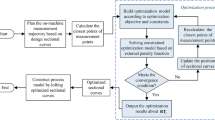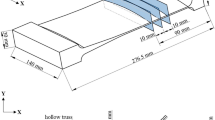Abstract
The shape of leading and trailing edges (LTEs) of a thin-walled blade is one of the key parameters that influence the performance of an aero-engine, and an exact evaluation of the shape is the basis to ensure machining quality. When the chord length of a blade is deviated, the actual position of LTEs deviates from the theoretical curve. However, considering the problem that chord length deviation couples with profile errors of LTEs, the deviation is introduced into the evaluation of profile errors with the standard iterative closest point (ICP) algorithm, which results in an inexact evaluation and affects the performance of the aero-engine. To address this issue, a novel method that exactly evaluates profile errors of LTEs is proposed. Firstly, a data pre-transformation function is introduced into the standard ICP algorithm to separate the relationship between the chord length deviation and profile errors of LTEs. Secondly, a data preprocessing optimization model is established with the constraints of chord length tolerance and camber curve, which can ensure the trend of the blade and the continuity of measuring data. Thirdly, the model is solved by the particle swarm optimization (PSO) algorithm. Finally, this method is applied to the evaluation of profile errors of LTEs of an open blisk using simulation and experimental data to verify its availability. The results show that the proposed method can eliminate the adverse effect of chord length deviation and realize the exact evaluation of the profile errors of LTEs.


















Similar content being viewed by others
Data availability
All data generated and analyzed during this study are included in this paper.
References
Wu DB, Wang H, Peng JS, Zhang KY, Yu J, Li Y, Wang MM, Zhang XD (2019) Analysis of machining deformation for adaptive CNC machining technology of near-net-shaped jet engine blade. Int J Adv Manuf Technol 104:3383–3400. https://doi.org/10.1007/s00170-019-03898-6
Cheng C, Wu BH, Zheng H, Gao LM (2019) Effect of blade machining errors on compressor performance. Acta Aeronaut Astronaut Sin 40:123237. https://doi.org/10.7527/S1000-6893.2019.23237
Schnell R, Lengyelkampmann T, Nicke E (2014) On the impact of geometric variability on fan aerodynamic performance, unsteady blade row interaction and its mechanical characteristics. J Turbomach Trans ASME 136:91005. https://doi.org/10.1115/1.4027218
Fathi A, Alizadeh M (2012) Effects of blade manufacturing deviations on turbine performance. ASME Gas Turbine India Conf:203–211. https://doi.org/10.1115/GTINDIA2012-9641
Lin XJ, Cui T, Yang BQ, Yang R, Xin XP (2019) Method for establishing machining and inspection model of multi-stage machining processes of thin-walled blade. Acta Aeronaut Astronaut Sin 40:423304. https://doi.org/10.7527/S1000-6893.2019.23034
Zhang WB, Ren JX (2020) Improving the machining dynamics performance and efficiency for complex channel part manufacturing by planning the tool orientations and feed rate sequence. Int J Adv Manuf Technol 107:3663–3689. https://doi.org/10.1007/s00170-020-05157-5
Xu RF, Cheng X, Zheng GM, Chen ZT (2017) A tool orientation smoothing method based on machine rotary axes for five-axis machining with ball end cutters. Int J Adv Manuf Technol 92:3615–3625. https://doi.org/10.1007/s00170-017-0403-1
Jia ZY, Wang L, Ma JW, Zhao K, Liu W (2014) Feed speed scheduling method for parts with rapidly varied geometric feature based on drive constraint of NC machine tool. Int J Mach Tools Manuf 87:73–88. https://doi.org/10.1016/j.ijmachtools.2014.07.010
Xiao GJ, Huang Y (2016) Equivalent self-adaptive belt grinding for the real-R edge of an aero-engine precision-forged blade. Int J Adv Manuf Technol 83:1697–1706. https://doi.org/10.1007/s00170-015-7680-3
Zhang JF, Shi YY, Lin XJ, Li ZS (2017) Five-axis abrasive belt flap wheel polishing method for leading and trailing edges of aero-engine blade. Int J Adv Manuf Technol 93:3383–3393. https://doi.org/10.1007/s00170-017-0717-z
Li YD, Gu PH (2006) Automatic localization and comparison for free-form surface inspection. J Manuf Syst 25:251–268. https://doi.org/10.1016/S0278-6125(08)00007-1
Li YD, Gu PH (2004) Free-form surface inspection techniques state of the art review. Comput Des 36:1395–1417. https://doi.org/10.1016/j.cad.2004.02.009
Besl PJ, McKay ND (1992) A method for registration of 3-D shapes. IEEE Trans Pattern Anal Mach Intell 14:239–256. https://doi.org/10.1109/34.121791
Zhu L, Barhak J, Srivatsan V, Katz R (2007) Efficient registration for precision inspection of free-form surfaces. Int J Adv Manuf Technol 32:505–515. https://doi.org/10.1007/s00170-005-0370-9
He WT, Li ZW, Guo YY, Cheng X, Zhong K, Shi YS (2018) A robust and accurate automated registration method for turbine blade precision metrology. Int J Adv Manuf Technol 97:3711–3721. https://doi.org/10.1007/s00170-018-2173-9
Zhang DH, Cheng YY, Bu K, Zhang SL (2009) Reliable alignment method for blade shape analysis considering its blend and twist deformation. Acta Aeronaut Astronaut Sin 030:2449–2455
Lv BS, Cheng YY (2016) Profile tolerance constrained registration method for blade model. Comput Integr Manuf Syst 22:1831–1836. https://doi.org/10.13196/j.cims.2016.08.001
Wu BH, Wang J, Zhang Y, Luo M (2015) Adaptive location of repaired blade for multi-axis milling. J Comput Des Eng 2:261–267. https://doi.org/10.1016/j.jcde.2015.06.009
Zhang Y, Zhang DH, Wu BH (2015) An approach for machining allowance optimization of complex parts with integrated structure. J Comput Des Eng 2:248–252. https://doi.org/10.1016/j.jcde.2015.06.007
Sun YW, Xu JT, Guo DM, Jia ZY (2009) A unified localization approach for machining allowance optimization of complex curved surfaces. Precis Eng Int Soc Precis Eng Nanotechnol 33:516–523. https://doi.org/10.1016/j.precisioneng.2009.02.003
Roberts WB, Armin A, Kassaseya G, Suder KL, Thorp SA, Strazisar AJ (2002) The effect of variable chord length on transonic axial rotor performance. J Turbomach 124:V001T03A080. https://doi.org/10.1115/1.1459734
Giebmanns A, Schnell R, Steinert W, Hergt A, Nicke E, Werner-Spatz C (2012) Analyzing and optimizing geometrically degraded transonic fan blades by means of 2D and 3D simulations and cascade measurements. Am Soc Mech Eng Proc ASME Turbo Expo 2012 Copenhagen ASME 279–288. https://doi.org/10.1115/GT2012-69064
Hsieh H, Chu C (2012) Optimization of tool path planning in 5-axis flank milling of ruled surfaces with improved PSO. Int J Precis Eng Manuf 13:77–84. https://doi.org/10.1007/s12541-012-0011-9
Acknowledgments
The authors gratefully acknowledge the supports of the National Science and Technology Major Project on CNC Machine tool, China (No. 2018ZX04019001).
Funding
This paper received financial support from the National Science and Technology Major Project on CNC Machine tool, China (No. 2018ZX04019001).
Author information
Authors and Affiliations
Contributions
Qian Feng wrote the manuscript and contributed to the conception of the study.
Xiaojun Lin contributed to the conception of the study.
Yongshou Liang contributed significantly to analysis and manuscript preparation.
Zhiwei Wang performed the experiment.
Junxue Ren helped perform the analysis with constructive discussions.
Corresponding author
Ethics declarations
Competing interests
The authors declare that they have no competing of interest.
Ethical approval
Not applicable.
Consent to participate
Not applicable.
Consent to publish
The authors consent to publish this paper.
Additional information
Publisher’s note
Springer Nature remains neutral with regard to jurisdictional claims in published maps and institutional affiliations.
Rights and permissions
About this article
Cite this article
Feng, Q., Lin, X., Liang, Y. et al. The evaluation of profile errors of the leading and trailing edges of a thin-walled blade based on chord length deviation. Int J Adv Manuf Technol 112, 3053–3067 (2021). https://doi.org/10.1007/s00170-020-06569-z
Received:
Accepted:
Published:
Issue Date:
DOI: https://doi.org/10.1007/s00170-020-06569-z




